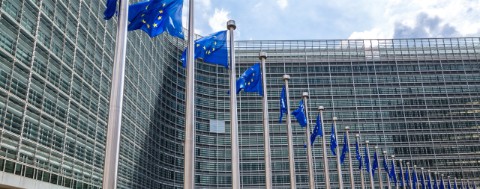With some 1.2 million inhabitants, Brussels is far from competing with the major European capitals of London (8.7 million inhabitants), Berlin (3.7 million), Madrid (3.1 million) or Paris (2.2 million). Nevertheless, its role as the capital of Europe makes it an essential institutional, administrative, financial and tourist crossroads. And it is one of the most densely populated cities in Europe (almost 7,500 inhabitants per km2). More than 100 nationalities live together here and Brussels has the largest number of embassies after Washington. But whether for professional reasons or personal choice, the charm of the city always manages to charm those who come to settle here. Beyond the traditional stereotypes, Brussels has many different faces to offer. Here are 5 preconceived ideas about Brussels... and how to shut them down!
Weare very proud: the Grand Place is quite simply one of the most beautiful in the world! And even when you've lived in Brussels for years, you never get tired of admiring it. So yes, you have to go there. And walk just a few hundred yards to see that renowned kid who never stops peeing (to be clear, this Brussels "ket" is 55 cm tall... so don't expect the Statue of Liberty!). As for the Atomium, located north of Brussels and built in 1958 for the Brussels World Fair, after which it was supposed to be dismantled; today it is one of the most visited structures in the capital. And in 2018 it celebrates its 60th birthday... the perfect opportunity to extend your trip with a visit to the ADAM museum right next door, which has an exhibition dedicated to the Atomium, entitled Galaxy 58.
Antidote: Of course, Brussels is not made up of just these three hot spots, and it would be impossible to list all the things to see in Brussels here. Just know that the city centre is divided between high and low (you will quickly understand why, especially if you use a bike to get around!). The historic centre around the Grand Place is located in the lower part of the city. Don't miss a trip to the Bourse (which will soon be transformed into the "Beer Temple"), the pedestrian zone surrounding it (highly criticised since its creation, but undergoing constant improvements) and the very trendy Dansaert area, where you can find fashion designers and legendary locations, like the Archiduc bar or the Noordzee fishmonger's table and plenty of restaurants that are really worth a visit Rue de Flandre.
On the other side of the Grand Place stands the majestic Mont des Arts, which climbs up to the top of the city. There you can find the Royal Library, and from the top of the stairs the view is phenomenal. The BOZAR Centre for Fine Arts and the MIM are within walking distance, as well as Place Royale, the Royal Palace and its park, the Fine Arts Museums (including the very popular Magritte), and much more! The ascent of the Rue de Namur will finish off your calf muscles with a luxury shopping stroll that will take you to the shopping areas of Avenue Louise (next to Place Louise, make sure to take a look at the imposing Palais de Justice and the magnificent view of the city). At the very end of Avenue Louise, to recover from your emotions, your shopping and your efforts, the Bois de la Cambre, the real green heart of the city, will surprise you with its expanse, its lawns and its relaxing water features. Congratulations, you have just completed an express tour of the city of Brussels. All that remains for you to do now is to discover the other 18 districts of the capital, which are like small villages in the city. To discover more, read this article on expats' favourite neighbourhoods.
According to the New York Times, the best fries in the world are to be eaten in Brussels. At Maison Antoine on Place Jourdan
(Etterbeek) to be precise. But the fries stand that is a hit today is the one at Place Flagey in Ixelles, aptly named Frit'Flagey, even if the picturesque "fritkots" are tending to disappear in Brussels. For waffles, what you need to know is that those in Brussels have a crispy, light dough and deep gaps (the other, smaller and chunkier waffles, are Liège waffles). They can be enjoyed sprinkled with sugar, or adorned with a topping of your choice, such as fresh cream or chocolate. And speaking of chocolate, while visiting its museum in the centre, it is in Sablon that you will find the most prestigious chocolate makers such as Marcolini, Wittamer, Neuhaus or the surprising Patrick Roger.
Antidote: If you want to protec your liver, know that good food here goes well beyond these traditional delicacies. There are more than 2,000 restaurants in Brussels, including 17 Michelin-starred restaurants (Bruneau and Wy closed their doors but Bruneau will reopen soon), from the legendary Comme chez Soi to the mind-blowing Bon Bon. And then there's Brussels' playful side: you can enjoy gastronomic delights on a tram ride (Tram Experience) or with your head in the clouds (Dinner in the Sky). And if you want something "typical", there is no shortage of real Brussels establishments, the most authentic of all undoubtedly being the Friture René in Anderlecht. But what really seduces gourmets is the attention paid to the décor, the atmosphere, the service, the quality, the diversity and sometimes even the originality. Not only that, but the range of choices: there are as many cuisines in Brussels as there are nationalities. And what is always surprising is the ability of the people of Brussels to extend lunch (it is not uncommon for lunch to last several hours, even when it is for business). Did someone say bons vivants? We certainly are! More inspiration on Brussels Kitchen, "the guide to food with style".
Yes, just like in Paris you have to visit the Louvre, in Amsterdam the Rikjsmuseum or the Met when you're in New York... Better yet, the Royal Museums of Fine Arts are five museums in one. From the old Flemish masters and primitives to the modern section, without forgetting the must-visit Magritte Museum, which offers more than 200 works by the famous Belgian surrealist, making it the largest collection in the world.
Antidote: This is more of a stimulant than an antidote! Because Brussels museums are like the city: there's something for everyone! Our favourites? We hold a candle for Train World in Schaerbeek, an incredible museum that really takes you on a journey. Another curiosity is the MIMA, the iconoclastic museum of urban art located along the canal in Molenbeek is one of the newest in Brussels. But there is also the surprising Musical Instrument Museum (MIM) whose building alone is worth the trip, or the essential visit to the Horta Museum in Ixelles and a little hidden gem in Uccle, the Van Buuren Museum.
Want to relax? Why not try a cinema? As well as the UGC cinemas at the top (Toison d'Or) and bottom of the city (De Brouckère), several independent cinemas are worth a visit. For example, the super stylish White Cinéma at the Docks, a brand new shopping centre in Schaerbeek, or the sublime Palace, a stone's throw from the Bourse, which has just reopened its doors after a thorough renovation.
Better than that: they're literally part of the landscape. Just follow the comic book route, a series of monumental frescoes that allow you to discover the city centre in an original way. A walk to finish off with a visit to the comic museum, or the Belgian Comic Strip Centre to give it its real title.
Antidote: We'll offer a complementary therapy instead. Because there's no better way to get stuck into a comic book than getting settled into a specialist shop (be careful, this antidote can quickly lead to an addiction!). There are many of them in Brussels; here are some where you might want to linger to leaf through (and buy) your favourite strips: Brüsel, Slumberland, The Skull, Le Dépôt de Bruxelles. But not forgetting Filigranes, the most essential (and largest) bookshop in Brussels (a must-see with its own restaurant) or Pêle-Mêle (Ixelles and Brussels City), a real second-hand paradise.
Although Brussels is pretty fun-loving, it's not uncommon to hear tourists or newcomers complain about the fact that everywhere closes early in Brussels and that there's not much going on. This is true in certain tourist areas, such as the centre of Brussels. But, as in all big cities, it's all about knowing the right neighbourhoods and the right places to be. The guides will often mention the cabarets and other entertainment restaurants in the centre... which the people of Brussels do not frequent!
Antidote: For your first outing in the city, make sure you're accompanied by locals who love to party! Some advice... Aperitifs are now served at evening market stalls (until about 9pm) in different districts. A market for every day of the week: Monday at Place Van Menen in Saint-Gilles, Wednesday at Place du Châtelain in Ixelles, Friday at Place des Ardennais in Schaerbeek, Sunday (morning) at Place Wiener in Boitsfort... The evening continues in a restaurant or in the bars... (Ixelles and Saint-Gilles are like two villages that are full of trendy venues)... And for the night time enthusiasts, several clubs get the people of Brussels dancing. Including the very popular Jeux d’Hiver in the Bois de la Cambre, which has the particularity of attracting both a young and older clientèle in the same place (but in two distinct spaces). Every Thursday from 8pm they organise the Aperitivo Milano, a particular favourite of expats.
So yes, Brussels is sometimes a bit strange and it often seems like complete chaos... But once you get to know it, you can't leave it. Original in more ways than one, always on the move, playing hide-and-seek with those who try to discover it better, revealing itself to those who make the effort to look deeper, Brussels still charms you and always will. But it may also be bewildering, feeling both welcoming and closed off at the same time. This is why the door at KBC Brussels is probably one of the first to be opened when you decide to move to Brussels!


